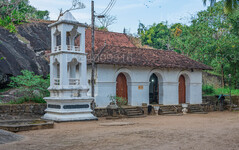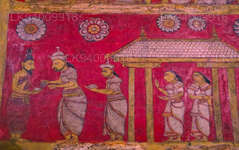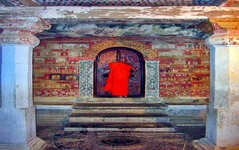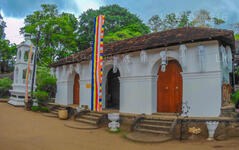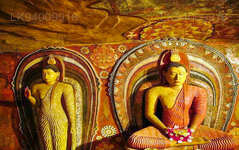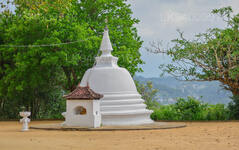
Kandy City
Kandy, a picturesque city in central Sri Lanka, is renowned for its rich cultural heritage, vibrant festivals, and scenic beauty. Nestled amidst lush hills, it is home to the Temple of the Tooth Relic, a UNESCO World Heritage Site, and offers a captivating blend of history and natural splendor.
Degaldoruwa Raja Maha Vihara
Amongst the rocky slopes and green valleys of rural Kandy lies a hidden treasure; the Degaldoruwa Raja Maha Vihara. This temple awes those who view it with its incredible Kandyan era frescoes. Construction of the temple began in the late 1770s under the reign of King Kirti Sri Rajasinha and was completed under the reign of his brother Rajadhi Rajasinha years later.
Legend
According to folklore a farmer was exploring the area and found a crevice between two rocks. On venturing into space he found a cave with a pile of golden sickles. The farmer was delighted with his discovery but feared retribution from some strange power. So he simply took only one sickle every morning and, after using it in his fields, returned it in the evening. His fields yielded an extremely healthy harvest and the farmer attributed it to the golden sickle. But then he became greedy. After all, he had been taking the sickles every day and there had been no ill effects, and there was a whole pile of them. So on the very last day of the harvest, he took two sickles instead of one and did not return one of them.
But unknown to the farmer, there had indeed been a guardian for the treasure. The guardian noticed the farmer taking the sickles, but kept quiet as he always returned them. On the day that the farmer took one sickle for himself, the guardian saw it at once and confronted him in his home. The terrified farmer immediately rushed to the crevice and returned the golden sickle that he had stolen. The guardian, who had been disappointed, then sealed the crevice by fusing the two rocks together. However, the villagers got to know this story and informed the king, Kirti Sri Rajasinha; who then ordered that the cave be found and a temple erected in it.
The Structure
- The temple is hollowed out of a 40 foot rock outcrop extending a natural cave. It consists of an elegant rock shelter with two roofed antechambers in front; a drummers’ hall and an image house; and the main shrine room cut into the rock itself. The two antechambers are constructed outside the rock outcrop and have wooden roofs.
- The architecture is unusual for the period as the drummers’ hall is not usually attached to the main temple.
- The image house is located through a set of old wooden doors, situated under a carved wooden Dragon Arch. It preserves a moonstone and a sequence of elaborate and colorful paintings showing scenes from four Jātaka tales, which tell the stories of the previous lives of Buddha.
- The door of the shrine room is banded with metal and once had jewels embedded within it. The inner walls of the shrine are completely covered in paintings; including the door.
- In addition to this main structure, there is a bo tree and a stupa on a plateau on the summit of the rocky outcrop above the temple. They can be reached by stairs carved into the temple.
The Frescoes
The paintings of Degaldoruwa, which are supposed to be some of the best of the Kandyan era, are believed to be the work of four ‘Sittara’ artists. The finest of these paintings grace the ceiling of the temple; ‘Mara Yudde’, an artistic depiction of Buddha’s internal spiritual battle against Māra, the demon of death, rebirth, and desire.
The murals are unique in that all the elements; the people, the trees and the animals; are a uniform size and only the front views of ]people are shown. The trees have a stylized form, with their branches and leave spreading out to either side. The individual elements, such as the adornments on the elephants and the uniforms of the attendants, are portrayed in great detail. All of the colors used by the artists in the murals were created from the barks
About Kandy District
Kandy district is situated in the centrel province of Sri Lanka. One of the seven World Heritage Sites in Sri Lanka, Kandy was once home to the Kandyan Kings of yore in the 16th-century and a fountainhead for all the music, arts, crafts and culture in the country. About 129 km away from Colombo, Kandy is ensconced amongst a hilly terrain and all eyes are drawn to the centre of the city, where the Kandy Lake forms a charming feature. Kandy retains great religious significance for Sri Lanka, because it is in this charming city that the Dalada Maligawa or "Temple of the Tooth" is located, within which the sacred tooth relic of Lord Buddha lies well guarded.
The Royal Botanical Garden, Peradeniya is situated about 5 km to the west of the city centre at Peradeniya and is visited by 1.2 million people per year. It is the largest botanical garden on the island. The Udawatta Kele (Udawatta Forest) is a protected sanctuary situated in the heart of the city, just north of Temple of the Tooth.
Kandy is a Sinhala majority city; there are sizeable communities belonging to other ethnic groups, such as Moors and Tamils. Kandy is second only to Colombo the center of the Sri Lankan Economy. Many major co operations have large branch officers in Kandy and many industries include textiles, furniture, Information Technology and jewellery are found here. Many agriculture research centers are located in the city.
And a fountainhead for all the music, arts, crafts and culture in the country. About 129 km away from Colombo, Kandy is ensconced amongst a hilly terrain and all eyes are drawn to the centre of the city, where the Kandy Lake forms a charming feature. Kandy retains great religious significance for Sri Lanka , because it is in this charming city that the Dalada Maligawa or Temple of the Toothis located, within which the sacred tooth relic of Lord Buddha lies well guarded.
About Central Provincce
The Central Province of Sri Lanka consists primarily of mountainous terrain. The province has an area of 5,674 km², and a population of 2,421,148. Some major towns include Kandy, Gampola (24,730), Nuwara Eliya and Bandarawela. The population is a mixture of Sinhalese, Tamil and the Moors.
Both the hill capital Kandy and the city of Nuwara Eliya are located within the Central Province as well as Sri Pada. The province produces much of the famous Ceylon tea, planted by the British in the 1860s after a devastating disease killed all the coffee plantations in the province. Central Province attracts many tourists, with hill station towns such as Kandy, Gampola, Hatton and Nuwara Eliya. Temple tooth or Dalada maligawa is the main sacred place in Centrel province.
The climate is cool, and many areas about 1500 meters often have chilly nights. The western slopes are very wet, some places having almost 7000 mm of rain per year. The eastern slopes are parts of the mid-dry zone as it is receiving rain only from North-Eastern monsoon. The Temperatures range from 24°C at Kandy to just 16°C in Nuwara Eliya, which is located 1,889 m above sea level. The highest mountains in Sri Lanka are located in the Central Province. The terrain is mostly mountainous, with deep valleys cutting into it. The two main mountain regions are the central massif and the Knuckles range to the east of Kandy.

